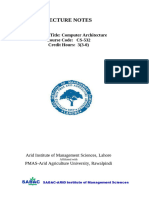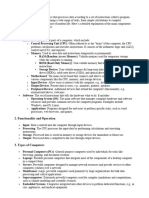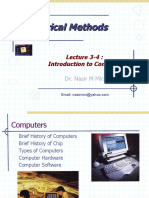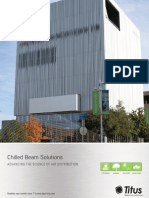0 ratings0% found this document useful (0 votes)
16 viewslect1-2 Introduction to Computer Hardware and Architecture
This lecture introduces the fundamental concepts of computer hardware and architecture, covering essential components such as the CPU, memory, and storage devices. It also discusses key architectural principles like the Von Neumann model and the importance of buses in data transfer. Understanding these basics is crucial for grasping how computers operate and interact with software.
Uploaded by
zayedalnaggarCopyright
© © All Rights Reserved
Available Formats
Download as PDF, TXT or read online on Scribd
0 ratings0% found this document useful (0 votes)
16 viewslect1-2 Introduction to Computer Hardware and Architecture
This lecture introduces the fundamental concepts of computer hardware and architecture, covering essential components such as the CPU, memory, and storage devices. It also discusses key architectural principles like the Von Neumann model and the importance of buses in data transfer. Understanding these basics is crucial for grasping how computers operate and interact with software.
Uploaded by
zayedalnaggarCopyright
© © All Rights Reserved
Available Formats
Download as PDF, TXT or read online on Scribd
You are on page 1/ 19
Lecture (1)
Introduction to Computer Hardware and
Architecture
Lecture Overview:
• This lecture provides an introduction to the fundamental concepts
of computer hardware and architecture. Students will gain an
understanding of the basic components of a computer system, their
functions, and how they work together to execute software. The
focus will be on understanding the structure, design, and interaction
of various hardware components within a computer.
Lecture Content
1. What is Computer Hardware?
• Definition: Hardware refers to the physical components of a
computer that you can touch and feel.
• Importance: Hardware is the foundation on which software runs,
and all digital processes depend on it.
• Examples: CPU, memory (RAM), storage devices (HDD/SSD),
input/output devices (keyboard, mouse, display).
2. The Basic Components of a Computer System
• Central Processing Unit (CPU):
o Brain of the computer, responsible for
executing instructions.
o Consists of Arithmetic Logic Unit (ALU)
(performs calculations) and Control Unit
(directs operations).
• Memory:
o RAM (Random Access Memory): Temporary
storage used for active data.
o ROM (Read-Only Memory): Permanent
storage used for firmware and essential
• Storage:
o Hard Disk Drive (HDD): Magnetic storage, slower and
larger.
o Solid State Drive (SSD): Faster, more durable, but generally
smaller in capacity.
• Input Devices:
o Devices used to enter data into the computer (keyboard,
mouse, scanner).
• Output Devices:
o Devices used to send data out of the computer (monitor,
printer, speakers).
3. Computer Architecture
• Definition: Computer architecture refers to the conceptual design and
functional operation of a computer system.
• Key Aspects:
o Instruction Set Architecture (ISA): The set of commands that the CPU
understands.
o Instruction Pipeline: Technique used in modern processors to increase
instruction throughput.
o Memory Hierarchy: The organization of various types of memory, such
as registers, cache, RAM, and storage.
4. The Von Neumann Model
• Basis for most modern computer architecture.
• Features:
o Shared memory for storing both data and
instructions.
o Sequential processing of instructions.
o Consists of Input → Processor → Memory
→ Output.
5. The Importance of Buses in Computer Architecture
• System Bus: Used to transfer data between the CPU,
memory, and peripherals.
• Types of Buses:
o Address Bus: Carries the address to access memory.
o Data Bus: Transfers actual data between components.
o Control Bus: Transmits control signals between
components.
6. Primary and Secondary Storage
• Primary Storage (RAM):
o Fast, temporary storage for active applications and data.
• Secondary Storage:
o Long-term storage (HDD, SSD, USB drives, etc.).
7. Input/Output (I/O) Devices
• How computers interact with the external
environment.
• Types:
o Human-Computer Interface: Keyboard, mouse,
touchscreen.
o Peripheral Devices: Printers, scanners, external
storage.
o Network I/O: Ethernet cards, wireless adapters.
8. Input Devices: 9.
Output Devices:
• Keyboard: Input for text and • Monitor: Visual output.
commands.
• Printer: Hardcopy
• Mouse: Pointer control. output.
• Scanner: Converts physical • Speakers: Audio
documents into digital form. output.
10. Data Communication in Computers
• Data transmission between devices, over networks.
• Key terms:
o Bit: The smallest unit of data.
o Byte: 8 bits.
o Bandwidth: The rate at which data is transferred.
• Overview of Computer Performance
• Clock Speed: Measured in GHz, dictates the speed at which
instructions are processed.
• Cores: Multiple cores improve parallel processing.
• Cache: Smaller, faster memory close to the CPU for frequently
accessed data.
• Instruction Set: Determines the types of instructions the CPU can
execute.
12. Types of Computer Architectures
• Harvard Architecture: Separate memory for data and instructions.
• Complex Instruction Set Computer (CISC): Uses instructions that
can perform complex tasks in one step.
• Reduced Instruction Set Computer (RISC): Uses simple
instructions, allowing for faster execution.
13. Performance Metrics
• MIPS: Millions of instructions per second.
• GHz: Frequency of clock cycles.
• Instruction Per Cycle (IPC): The number of instructions a CPU can
execute per cycle.
14. The Role of the Operating System
• Acts as an interface between hardware and software.
• Manages hardware resources (CPU, memory, storage).
• Provides services like process management, file system
management, and device management.
15. The Future of Computer Hardware
• Emerging trends:
• Quantum computing, neuromorphic computing,
and edge computing.
• Miniaturization and advances in
semiconductor technology.
Lecture Summary:
• In this lecture, we explored the fundamental components of
computer hardware, their roles, and how they interact within the
architecture. From CPUs and memory to I/O devices and storage,
understanding these basics is crucial to grasping the operation of
computers. Furthermore, we delved into key architectural
principles such as the Von Neumann model, instruction sets, and
data buses, which are foundational to modern computing.
You might also like
- IT FOR BUSSINESS COMPUTER ARCHITECTURENo ratings yetIT FOR BUSSINESS COMPUTER ARCHITECTURE19 pages
- 11 cs unit 1 one shot_240427_202128 (1)No ratings yet11 cs unit 1 one shot_240427_202128 (1)56 pages
- 11 cs unit 1 one shot_240427_202128 (1)No ratings yet11 cs unit 1 one shot_240427_202128 (1)56 pages
- Computer System Lecture 1 262d12de 618c 47a0 a96d 2cd50a6b3645No ratings yetComputer System Lecture 1 262d12de 618c 47a0 a96d 2cd50a6b364541 pages
- 1 - Introduction To Computer FundamentalsNo ratings yet1 - Introduction To Computer Fundamentals9 pages
- 1- Introduction to Computer ArchitectureNo ratings yet1- Introduction to Computer Architecture9 pages
- Computer Is An Electronic Device Which Can Process Large Amount of Data With Very High Speed and AccuracyNo ratings yetComputer Is An Electronic Device Which Can Process Large Amount of Data With Very High Speed and Accuracy41 pages
- Overview of Computer Hardware 25 SlidesNo ratings yetOverview of Computer Hardware 25 Slides26 pages
- Hardware_Computer_Systems_and_Components 3rd lecNo ratings yetHardware_Computer_Systems_and_Components 3rd lec14 pages
- Introduction To Micro-Processors & Micro-ControllersNo ratings yetIntroduction To Micro-Processors & Micro-Controllers62 pages
- Computer Science: Learn about Algorithms, Cybersecurity, Databases, Operating Systems, and Web DesignFrom EverandComputer Science: Learn about Algorithms, Cybersecurity, Databases, Operating Systems, and Web DesignNo ratings yet
- Fundamentals of Modern Computer Architecture: From Logic Gates to Parallel ProcessingFrom EverandFundamentals of Modern Computer Architecture: From Logic Gates to Parallel ProcessingNo ratings yet
- Military Railway Unit Histories Held at MHINo ratings yetMilitary Railway Unit Histories Held at MHI6 pages
- Date of Preparing: 9/9/2023 Date of Teaching: 15/9/2023 Period: 02No ratings yetDate of Preparing: 9/9/2023 Date of Teaching: 15/9/2023 Period: 029 pages
- Questions 21 To 41, Choose The Appropriate Option To Complete The DialoguesNo ratings yetQuestions 21 To 41, Choose The Appropriate Option To Complete The Dialogues7 pages
- 1926.1411 - Power Line Safety-While Traveling Under or Near Power Lines With No Load. - Occupational Safety and Health AdministrationNo ratings yet1926.1411 - Power Line Safety-While Traveling Under or Near Power Lines With No Load. - Occupational Safety and Health Administration3 pages
- Beginning of The Dutch Delta Project. Engineers With The Delta Project Worked Together. TheyNo ratings yetBeginning of The Dutch Delta Project. Engineers With The Delta Project Worked Together. They2 pages
- Water Seepage Investigation Report (Pioneer) 6 Aug 2021No ratings yetWater Seepage Investigation Report (Pioneer) 6 Aug 202145 pages
- Grade 3 - Connect - Final Revision - First TermNo ratings yetGrade 3 - Connect - Final Revision - First Term9 pages
- Computer System Lecture 1 262d12de 618c 47a0 a96d 2cd50a6b3645Computer System Lecture 1 262d12de 618c 47a0 a96d 2cd50a6b3645
- Computer Is An Electronic Device Which Can Process Large Amount of Data With Very High Speed and AccuracyComputer Is An Electronic Device Which Can Process Large Amount of Data With Very High Speed and Accuracy
- Introduction To Micro-Processors & Micro-ControllersIntroduction To Micro-Processors & Micro-Controllers
- Computer Science: Learn about Algorithms, Cybersecurity, Databases, Operating Systems, and Web DesignFrom EverandComputer Science: Learn about Algorithms, Cybersecurity, Databases, Operating Systems, and Web Design
- Fundamentals of Modern Computer Architecture: From Logic Gates to Parallel ProcessingFrom EverandFundamentals of Modern Computer Architecture: From Logic Gates to Parallel Processing
- Date of Preparing: 9/9/2023 Date of Teaching: 15/9/2023 Period: 02Date of Preparing: 9/9/2023 Date of Teaching: 15/9/2023 Period: 02
- Questions 21 To 41, Choose The Appropriate Option To Complete The DialoguesQuestions 21 To 41, Choose The Appropriate Option To Complete The Dialogues
- 1926.1411 - Power Line Safety-While Traveling Under or Near Power Lines With No Load. - Occupational Safety and Health Administration1926.1411 - Power Line Safety-While Traveling Under or Near Power Lines With No Load. - Occupational Safety and Health Administration
- Beginning of The Dutch Delta Project. Engineers With The Delta Project Worked Together. TheyBeginning of The Dutch Delta Project. Engineers With The Delta Project Worked Together. They
- Water Seepage Investigation Report (Pioneer) 6 Aug 2021Water Seepage Investigation Report (Pioneer) 6 Aug 2021
























































































